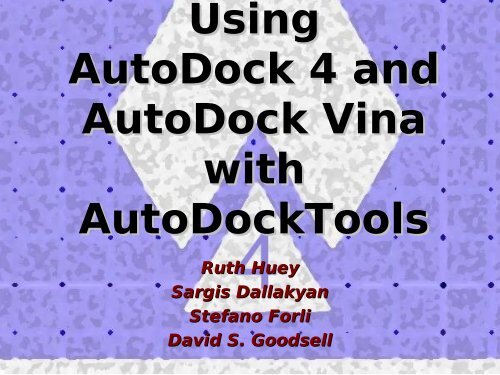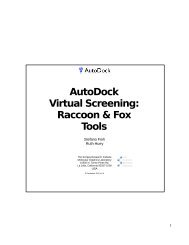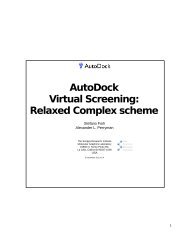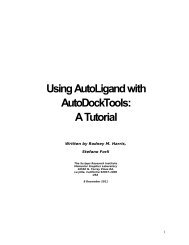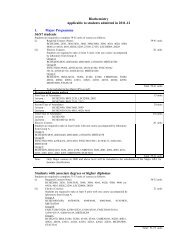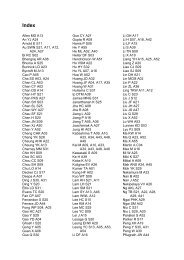Create successful ePaper yourself
Turn your PDF publications into a flip-book with our unique Google optimized e-Paper software.
Using<br />
<strong>AutoDock</strong> 4 and<br />
<strong>AutoDock</strong> Vina<br />
with<br />
<strong>AutoDock</strong>Tools<br />
Ruth Huey<br />
Sargis Dallakyan<br />
Stefano Forli<br />
David S. Goodsell<br />
12/08/11 Using <strong>AutoDock</strong> 4 with ADT 1
What is Docking?<br />
Given the 3D structures of two molecules,<br />
determine the best binding modes.<br />
12/08/11 Using <strong>AutoDock</strong> 4 with ADT 2
Key aspects of docking…<br />
� Scoring Functions<br />
� Predicting the energy of a particular pose<br />
� Often a trade-off between speed and<br />
accuracy<br />
� Search Methods<br />
� Finding an optimal pose<br />
� Which search method should I use?<br />
� Dimensionality<br />
� Can we trust the answer?<br />
12/08/11 Using <strong>AutoDock</strong> 4 with ADT 3
� 1990 - <strong>AutoDock</strong> 1<br />
<strong>AutoDock</strong> History<br />
� First docking method with flexible ligands<br />
� 1998 - <strong>AutoDock</strong> 3<br />
� Free energy force field and advanced search methods<br />
� <strong>AutoDock</strong>Tools Graphical User Interface<br />
� 2009 - <strong>AutoDock</strong> 4<br />
� Current version of <strong>AutoDock</strong><br />
� Many parameters available to user<br />
� 2009 - <strong>AutoDock</strong> Vina<br />
� Rewritten by Oleg Trott, new approach to scoring and<br />
search<br />
� One step solution to docking<br />
12/08/11 Using <strong>AutoDock</strong> 4 with ADT 4
Scoring Functions<br />
ΔG binding = ΔG vdW + ΔG elec + ΔG hbond + ΔG desolv + ΔG tors<br />
12/08/11 Using <strong>AutoDock</strong> 4 with ADT 5
Dispersion/Repulsion<br />
ΔG binding = ΔG vdW + ΔG elec + ΔG hbond + ΔG desolv + ΔG tors<br />
12/08/11 Using <strong>AutoDock</strong> 4 with ADT 6
Electrostatics and Hydrogen Bonds<br />
ΔG binding = ΔG vdW + ΔG elec + ΔG hbond + ΔG desolv + ΔG tors<br />
12/08/11 Using <strong>AutoDock</strong> 4 with ADT 7
Desolvation<br />
ΔG binding = ΔG vdW + ΔG elec + ΔG hbond + ΔG desolv + ΔG tors<br />
12/08/11 Using <strong>AutoDock</strong> 4 with ADT 8
Torsional Entropy<br />
ΔG binding = ΔG vdW + ΔG elec + ΔG hbond + ΔG desolv + ΔG tors<br />
12/08/11 Using <strong>AutoDock</strong> 4 with ADT 9
€<br />
W vdw<br />
W hbond<br />
W elec<br />
W sol<br />
<strong>AutoDock</strong> Empirical<br />
Free Energy Force Field<br />
Aij 12<br />
rij − B ⎛ ⎞<br />
ij<br />
∑ ⎜ ⎟ 6<br />
⎝ r<br />
⎟ +<br />
i, j<br />
ij ⎠<br />
E(t) Cij 12<br />
rij − D ⎛ ⎞<br />
ij<br />
∑ ⎜ ⎟ 10<br />
⎝ r<br />
⎟ +<br />
i, j<br />
ij ⎠<br />
qiq j<br />
∑ +<br />
ε(rij )rij i, j<br />
∑( SiV j + S jVi) e (−rij 2 / 2σ 2 )<br />
+<br />
i, j<br />
W tor N tor<br />
� Physics-based approach from<br />
molecular mechanics<br />
� Calibrated with 188 complexes from<br />
LPDB, K i’s from PDB-Bind<br />
� Standard error = 2.52 kcal/mol<br />
12/08/11 Using <strong>AutoDock</strong> 4 with ADT 10
<strong>AutoDock</strong> Vina Scoring<br />
Function<br />
Combination of knowledge-based and empirical approach<br />
ΔG binding = ΔG gauss + ΔG repulsion + ΔG hbond + ΔG hydrophobic + ΔG tors<br />
• ΔG gauss<br />
Attractive term for dispersion, two gaussian functions<br />
• ΔG repulsion<br />
Square of the distance if closer than a threshold value<br />
• ΔG hbond<br />
Ramp function - also used for interactions with metal ions<br />
• ΔG hydrophobic<br />
Ramp function<br />
• ΔG tors<br />
Proportional to the number of rotatable bonds<br />
� Calibrated with 1,300 complexes from PDB-Bind<br />
� Standard error = 2.85 kcal/mol<br />
http://vina.scripps.edu<br />
12/08/11 Using <strong>AutoDock</strong> 4 with ADT 11
Grid Maps<br />
� Precompute<br />
interactions for each<br />
type of atom<br />
� 100X faster than<br />
pairwise methods<br />
� Drawbacks: receptor is<br />
conformationally rigid,<br />
limits the search space<br />
12/08/11 Using <strong>AutoDock</strong> 4 with ADT 12
H-bond Grid Map<br />
Cytosine Guanine<br />
Huey, Goodsell, Morris, and Olson (2004) Letts. Drug Des. & Disc., 1: 178-183<br />
12/08/11 Using <strong>AutoDock</strong> 4 with ADT 13
Setting up the AutoGrid Box<br />
� Center:<br />
� center of ligand;<br />
� center of macromolecule;<br />
� a picked atom; or<br />
� typed-in x-, y- and z-coordinates.<br />
� Grid point spacing:<br />
� default is 0.375Å (from 0.2Å to 1.0Å: ).<br />
� Number of grid points in each dimension:<br />
� from 2 × 2 × 2 to 126 × 126 × 126<br />
� Make sure all the flexible parts of the macromolecule are<br />
inside the grid<br />
� Make sure that the entire binding site is inside the grid<br />
12/08/11 Using <strong>AutoDock</strong> 4 with ADT 14
Systematic<br />
� Exhaustive, deterministic<br />
� Outcome is dependent on<br />
granularity of sampling<br />
� Feasible only for lowdimensional<br />
problems<br />
Two Kinds of Search<br />
Stochastic<br />
� Random, outcome varies<br />
� Must repeat the search or<br />
perform more steps to improve<br />
chances of success<br />
� Feasible for larger problems<br />
12/08/11 Using <strong>AutoDock</strong> 4 with ADT 15
<strong>AutoDock</strong> and Vina Search<br />
Methods<br />
� Global search algorithms:<br />
� Simulated Annealing (Goodsell et al. 1990)<br />
� Genetic Algorithm (Morris et al. 1998)<br />
� Local search algorithm:<br />
� Solis & Wets (Morris et al. 1998)<br />
� Hybrid global-local search algorithm:<br />
� Lamarckian GA (Morris et al. 1998)<br />
� Iterated Local Search:<br />
� Genetic Algorithm with Local Gradient<br />
Optimization (Trott and Olson 2010)<br />
12/08/11 Using <strong>AutoDock</strong> 4 with ADT 16
Dimensionality of Molecular<br />
Docking<br />
Degrees of Freedom include:<br />
� Position / Translation (3)<br />
� x,y,z<br />
� Orientation / Quaternion (3)<br />
� qx, qy, qz, qw (normalized in 4D)<br />
� Rotatable Bonds / Torsions (n)<br />
� τ 1 , τ 2 , … τ n<br />
Dimensionality, D = 3 + 3 + n<br />
12/08/11 Using <strong>AutoDock</strong> 4 with ADT 17
Sampling Hyperspace<br />
� Say we are hunting in D-dimensional hyperspace…<br />
� We want to evaluate each of the D dimensions N<br />
times.<br />
� The number of “evals” needed, n, is: n = N D<br />
∴ N = n 1/D<br />
� For example, if n = 10 6 and…<br />
� D=6, N = (10 6 ) 1/6 = 10 evaluations per dimension<br />
� D=20, N = (10 6 ) 1/20 = ~2 evaluations per dimension<br />
� Clearly, the more dimensions, the tougher it gets.<br />
12/08/11 Using <strong>AutoDock</strong> 4 with ADT 18
Practical Considerations<br />
� What problems are feasible?<br />
� Depends on the search method:<br />
� Vina > LGA > GA >> SA >> LS<br />
� <strong>AutoDock</strong> SA : can output trajectories, D < 8<br />
torsions.<br />
� <strong>AutoDock</strong> LGA : D < 8-16 torsions.<br />
� Vina : good for 20-30 torsions.<br />
� When are <strong>AutoDock</strong> and Vina not suitable?<br />
� Modeled structure of poor quality;<br />
� Too many torsions (32 max);<br />
� Target protein too flexible.<br />
� Redocking studies are used to validate the<br />
method<br />
12/08/11 Using <strong>AutoDock</strong> 4 with ADT 19
Using <strong>AutoDock</strong>: Step-by-Step<br />
Prepare the Input Files<br />
Run AutoGrid 4<br />
Run <strong>AutoDock</strong> 4<br />
� Ligand PDBQT file<br />
Run ADT to Analyze<br />
DLG<br />
� Rigid Macromolecule PDBQT file<br />
� (Flexible Macromolecule PDBQT file )<br />
� AutoGrid Parameter File (GPF) and<br />
<strong>AutoDock</strong> Parameter File (DPF)<br />
� Or <strong>AutoDock</strong>Vina Parameter File<br />
Run <strong>AutoDock</strong> Vina<br />
Run ADT to Analyze results<br />
12/08/11 Using <strong>AutoDock</strong> 4 with ADT 20
PDBQT Format<br />
Coordinates from the Protein Data Bank with:<br />
� Polar hydrogen atoms<br />
� Atomic partial charges<br />
� Types (aromatic/aliphatic carbon, hydrogen bond<br />
donors/acceptors)<br />
� Center of rotation and rotatable bonds identified<br />
12/08/11 Using <strong>AutoDock</strong> 4 with ADT 21


